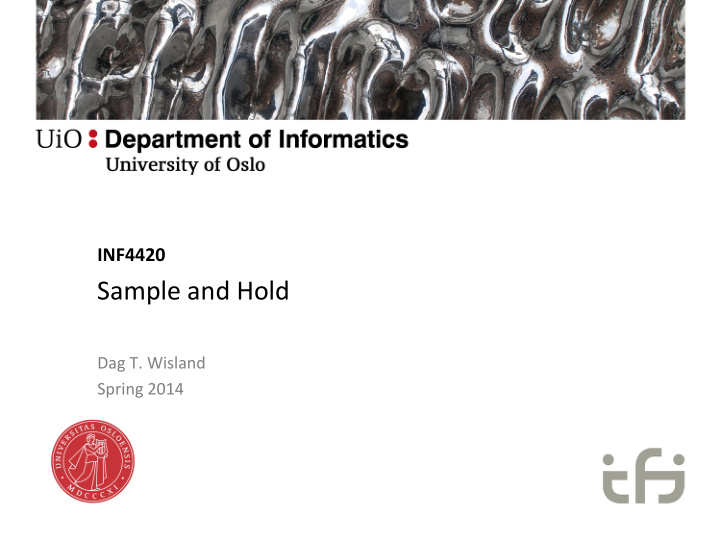



INF4420 Sample and Hold Dag T. Wisland Spring 2014
Outline • Sample and hold basics • Non ‐ ideal behavior • Sample and hold circuits Spring 2014 Sample and hold 2
Introduction • Take a “snapshot” of the input signal at an instant (sampling) • Need “memory” to keep the signal value • We know how to store digital values (latches and flip ‐ flops) • Capacitor as a memory element Spring 2014 Sample and hold 3
Introduction • Signal, x(t) , sampled at discrete time points, nT . Spring 2014 Sample and hold 4
Introduction Spring 2014 Sample and hold 5
Basic circuit • Sample and hold vs. track and hold Spring 2014 Sample and hold 6
Sample and hold Typically used to hold the input constant while converting from analog to digital. Limits performance, imperfections add directly to the input signal. In a later lecture we will see how sampling affects the signal. Spring 2014 Sample and hold 7
Non ‐ ideal behaviour • Hold step (signal dependence) • Coupling from output to sampled signal • Finite speed • Droop • Aperture jitter • Noise … Spring 2014 Sample and hold 8
Finite speed Spring 2014 Sample and hold 9
Finite speed Spring 2014 Sample and hold 10
Settling time Spring 2014 Sample and hold 11
Charge injection Switch transistor has channel • charge when “on” Charge flows out of the • channel when the transistor turns off Assume half the charge to • source and half to drain. (Depends …) Spring 2014 Sample and hold 12
Charge injection Spring 2014 Sample and hold 13
Clock feedthrough Spring 2014 Sample and hold 14
Jitter Spring 2014 Sample and hold 15
Closed loop S/H Generic solution to mitigate non ‐ ideal properties Gain + Negative feedback Spring 2014 Sample and hold 16
A better (?) S/H • Switch configures circuit in two states. Analyze separately Spring 2014 Sample and hold 17
A better (?) S/H • Eliminates non ‐ linearity of output buffer + • High input impedance + • Open loop opamp when switch is open – • Stability – • Can add switches to make sure the opamp is closed loop when holding Spring 2014 Sample and hold 18
A better S/H No signal dependent charge injection + • No signal dependent clock jitter + • Stability (worse than before) – • Spring 2014 Sample and hold 19
Inverting T/H Lowpass in track mode and signal independent charge Spring 2014 Sample and hold 20
Non ‐ inverting with cancelation Spring 2014 Sample and hold 21
Miller hold capacitance Spring 2014 Sample and hold 22
Switched capacitor (SC) S/H Spring 2014 Sample and hold 23
Recycling S/H Adds buffering Spring 2014 Sample and hold 24
SC S/H with lowpass filtering Spring 2014 Sample and hold 25
Bottom plate sampling Spring 2014 Sample and hold 26
High speed bipolar T/H Spring 2014 Sample and hold 27
Fully differential sample and hold • “Real” S/Hs are fully differential • We can modify many of the S/H discussed today to become fully differential Spring 2014 Sample and hold 28
Recommend
More recommend